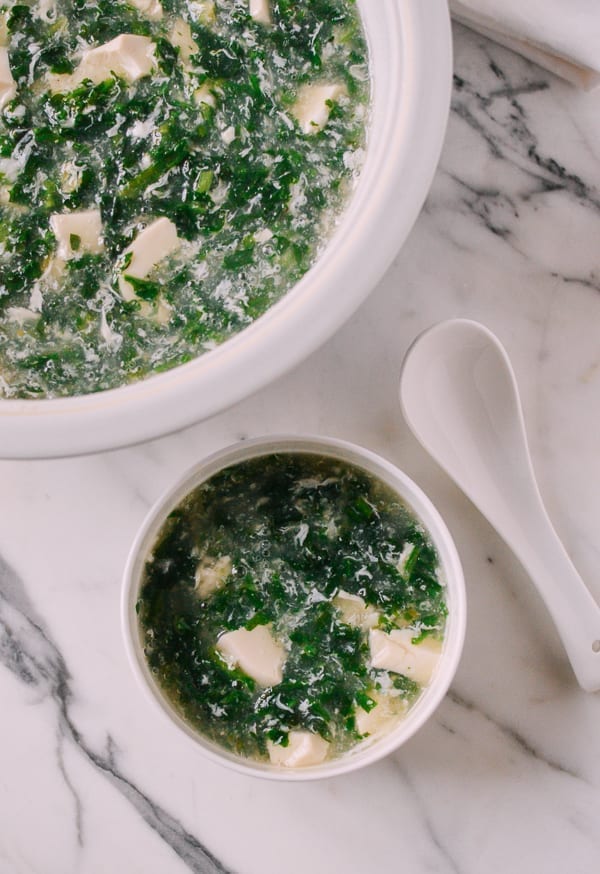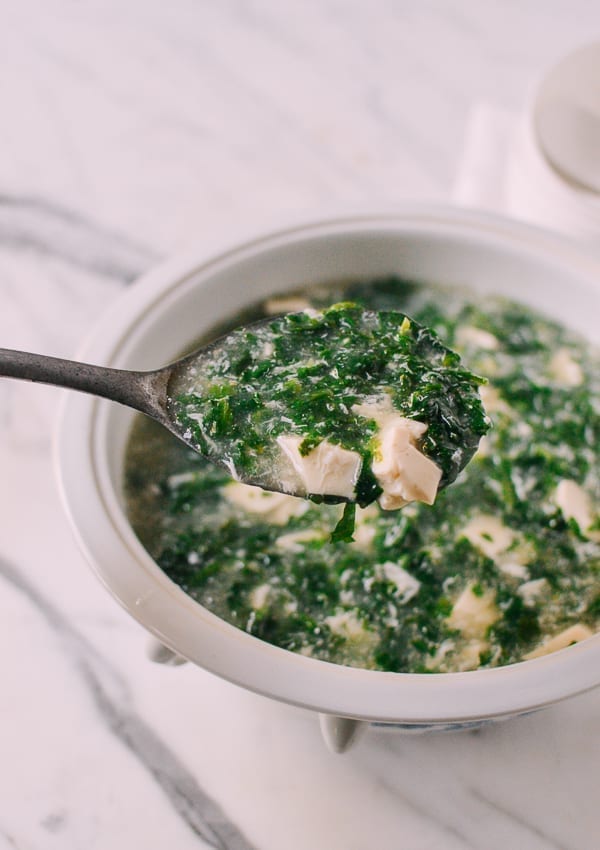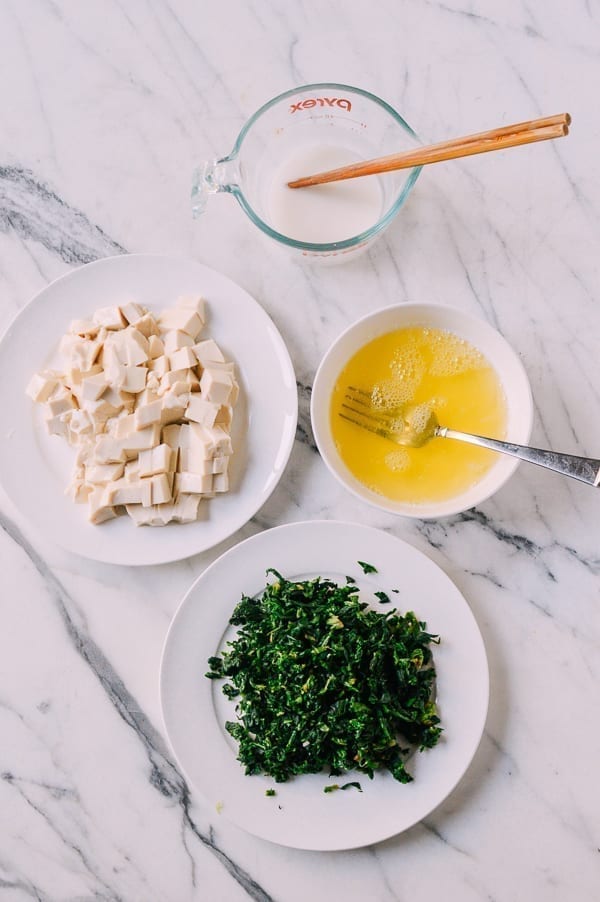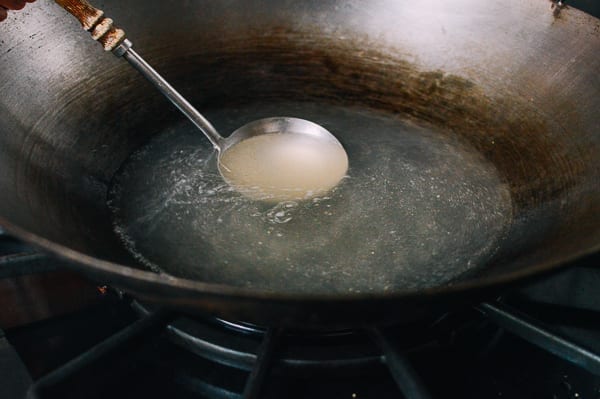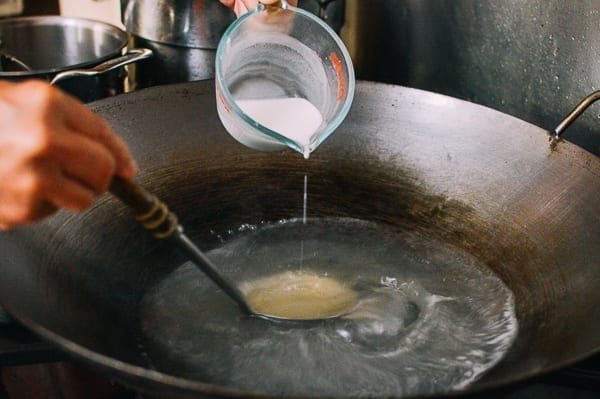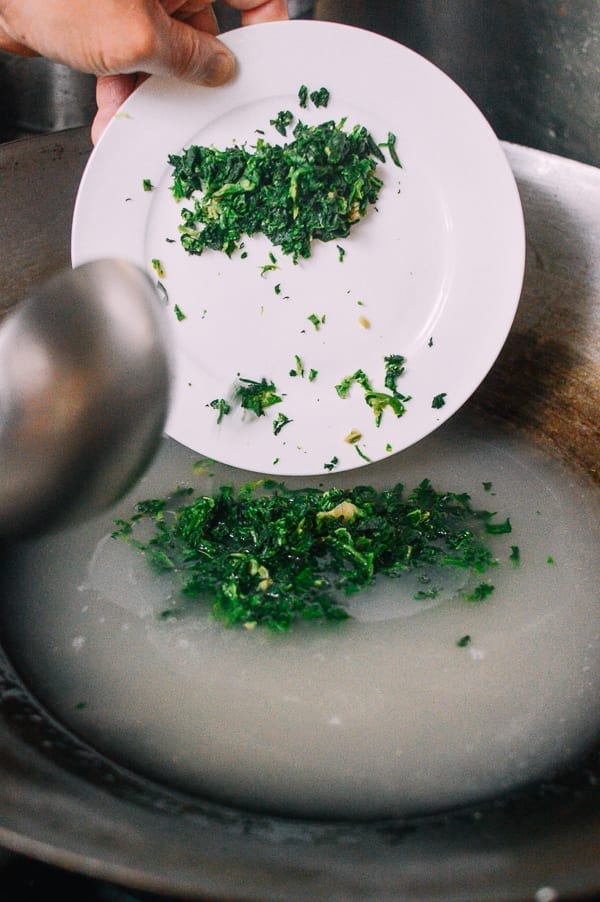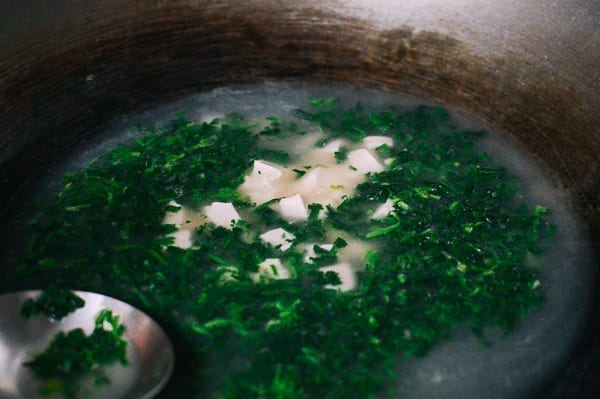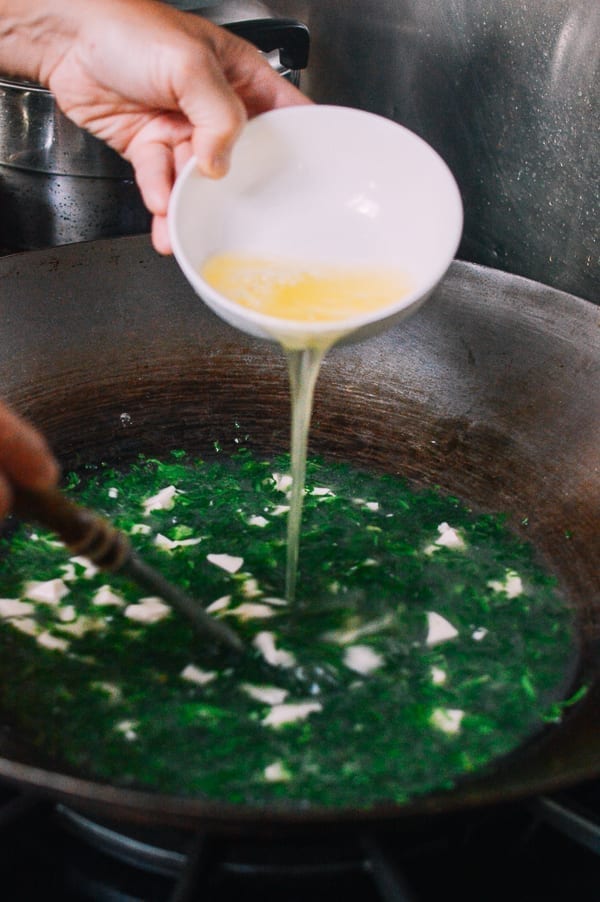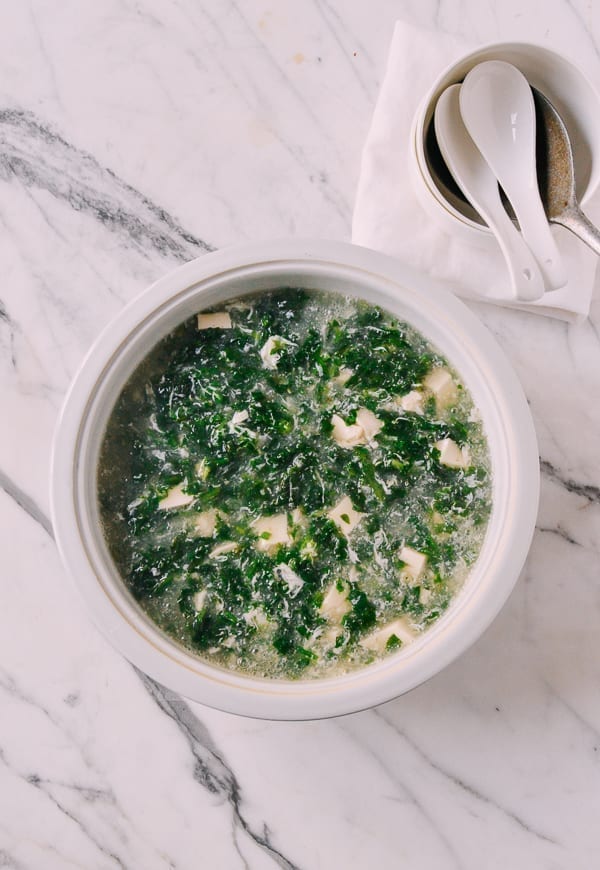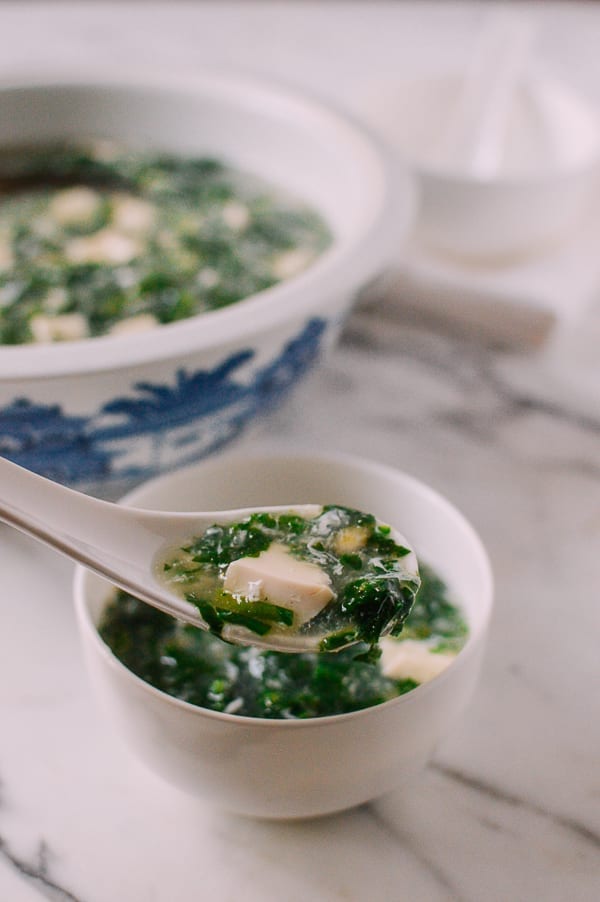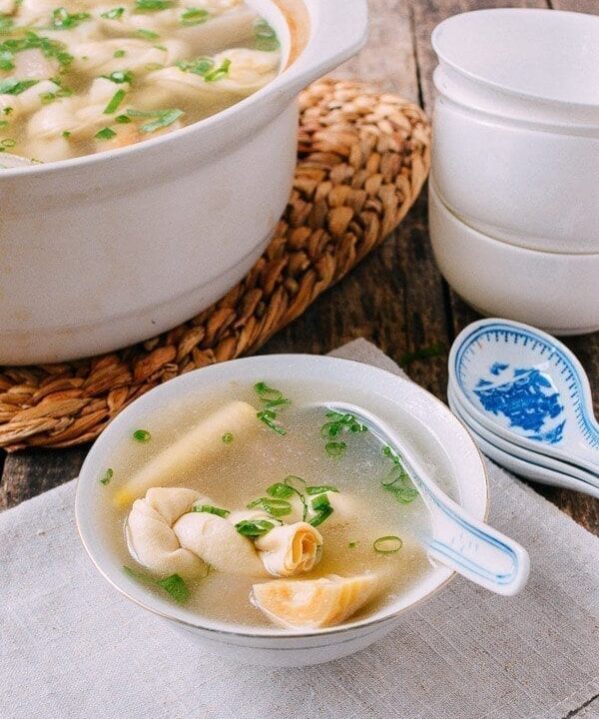Shepherd’s Purse Tofu Soup is a very well-known and popular soup in Shanghai. This special vegetable is wonderfully fragrant, with a unique flavor that you may know well from our Pork and Shepherd’s Purse (Ji Cai) Dumplings. You might also have seen jì cài (荠菜) in the freezer section of a well-stocked Chinese grocery store. If you’re unfamiliar with this vegetable, you can read more about it on our Chinese Leafy Greens page.
If you know us at The Woks of life, you may be wondering why Bill, the American Born Chinese (ABC) guy, is presenting this Shanghainese ji cai tofu soup and why Judy, the native born Shanghai city girl and now assimilated Chinese American is not making it.
I think it must be the same “wife technique” she used to make me cook our Ma Lan Tou with Spiced Tofu and the Sauteed Clover Cao Tou stir fry, both of which are iconic Shanghainese dishes.
Anyway, whatever the reason was, the bright side of the story is that I passed Judy’s taste test on all of these recipes!
Recipe Instructions
Prepare the shepherd’s purse by thawing it out in a colander. When it’s completely thawed, use your hands to gently squeeze the water from it. Chop the leaves into small pieces. Set aside. If you can’t find shepherd’s purse, try using frozen spinach.
Prepare, the silken tofu by cutting it into ½-inch cubes. Set aside. It can be tricky to keep them in a cube shape since the silken tofu is delicate, so don’t worry if they aren’t perfect.
Heat the chicken stock in a medium pot or wok. Add the salt, sesame oil, and ground white pepper. Let everything come to a slow simmer.
Stir up your cornstarch and water mixture since the cornstarch settles at the bottom of the bowl when left standing. Turn the heat down, and use your metal hoak or soup ladle to stir the soup in a circular motion so the soup is moving and swirling.
Slowly drizzle all of the cornstarch slurry into the soup while stirring. The trick to thickening the soup with cornstarch is to turn the heat down slightly and keep the soup moving so the cornstarch does not form clumps.
As you continue stirring, turn the heat back up to get the soup to a very low simmer. Check the soup for seasoning and add more salt if needed. Don’t worry if the soup tastes a little saltier than you’d like at this stage, because the Shepherd’s purse and the silken tofu are both unseasoned.
Simmer the soup for a minute, and add the chopped shepherd’s purse. Stir it gently until the leaves are well distributed.
Next, gently add the silken tofu cubes into the soup, and stir, taking care not to break up the tofu. You want to ensure that the tofu and shepherd’s purse are uniformly distributed in the soup and that both are heated evenly. The soup should start to simmer in about 2 to 4 minutes. At this point, you can add a bit more cornstarch slurry if you like a thicker soup, but keep in mind that the soup will thicken more as it cools.
Beat the egg whites briskly for about 10 seconds until the white is broken up and just starts to bubble.
Next, take your ladle or hoak and move it in a wide, steady swirling motion around the perimeter of the pot or wok until the soup is moving. Slowly drizzle the egg white into the soup.
The idea is to get the soup moving quickly enough and pour the egg whites at just the right speed to create what Chinese call “egg flowers” or dàn huā 蛋花, while preventing any large clumps from forming. The technique is the same for making egg drop soup, chicken corn egg drop soup or hot and sour soup. If you have made any of these soups before, then you know exactly what I am describing and trying to achieve with the egg whites.
At this point, adjust the heat so the soup is simmering. Taste the soup again, and season to taste with salt, white pepper, and sesame oil if needed. (Sesame oil and especially white pepper enhances the taste of the Shepherd’s purse, so you can add more or simply put these condiments on the table so they can be added as needed.)
Ladle the soup into bowls to serve or pour the soup into a larger family style soup bowl to serve at the table.
Shepherd’s Purse Tofu Soup
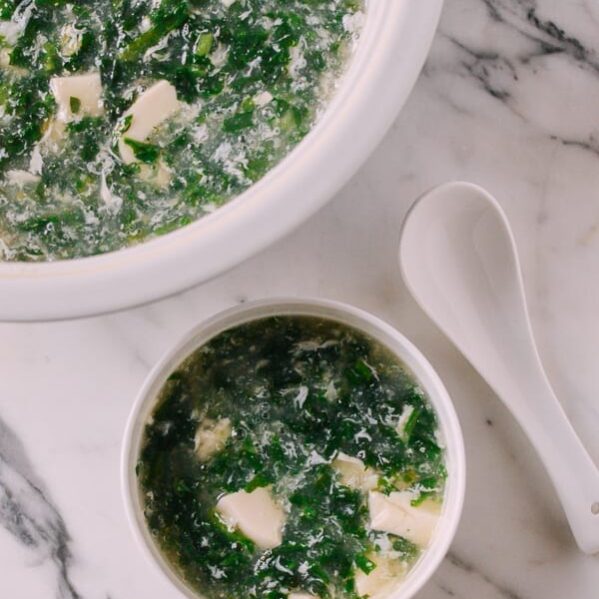
Ingredients
- 8 ounces frozen Shepherd’s purse (225g; can substitute frozen spinach)
- ½ block silken tofu (about 7 ounces, 200g)
- 4 cups homemade chicken stock
- 1 1/2 teaspoons salt (or to taste)
- 1 teaspoon sesame oil
- ¼ teaspoon ground white pepper (or to taste)
- 1/4 cup cornstarch (mixed with ¼ cup water)
- 3 egg whites
Instructions
- Prepare the shepherd’s purse by thawing it out in a colander. When it’s completely thawed, use your hands to gently squeeze the water from it. Chop the leaves into small pieces. Set aside.
- Prepare, the silken tofu by cutting it into ½-inch cubes. Set aside. It can be tricky to keep them in a cube shape since the silken tofu is delicate, so don’t worry if they aren’t perfect.
- Heat the chicken stock in a medium pot or wok. Add the salt, sesame oil, and ground white pepper. Let everything come to a slow simmer.
- Stir up your cornstarch and water mixture since the cornstarch settles at the bottom of the bowl when left standing. Turn the heat down, and use your metal hoak or soup ladle to stir the soup in a circular motion so the soup is moving and swirling. Slowly drizzle all of the cornstarch slurry into the soup while stirring. The trick to thickening the soup with cornstarch is to turn the heat down slightly and keep the soup moving so the cornstarch does not form clumps.
- As you continue stirring, turn the heat back up to get the soup to a very low simmer. Check the soup for seasoning and add more salt if needed. Don’t worry if the soup tastes a little saltier than you’d like at this stage, because the Shepherd’s purse and the silken tofu are both unseasoned.
- Simmer the soup for a minute, and add the chopped shepherd’s purse. Stir it gently until the leaves are well distributed.
- Next, gently add the silken tofu cubes into the soup, and stir, taking care not to break up the tofu. You want to ensure that the tofu and shepherd’s purse are uniformly distributed in the soup and that both are heated evenly. The soup should start to simmer in about 2 to 4 minutes. At this point, you can add a bit more cornstarch slurry if you like a thicker soup, but keep in mind that the soup will thicken more as it cools.
- Beat the egg whites briskly for about 10 seconds until the white is broken up and just starts to bubble.
- Next, take your ladle or hoak and move it in a wide, steady swirling motion around the perimeter of the pot or wok until the soup is moving. Slowly drizzle the egg white into the soup.
- At this point, adjust the heat so the soup is simmering. Taste the soup again, and season to taste with salt, white pepper, and sesame oil if needed. (Sesame oil and especially white pepper enhances the taste of the Shepherd’s purse, so you can add more or simply put these condiments on the table so they can be added as needed.)
- Ladle the soup into bowls to serve or pour the soup into a larger family style soup bowl to serve at the table.
